 One of the most extensive working conditions surveys of industrial workers
and probably the largest study of auto assembly plant workers.
One of the most extensive working conditions surveys of industrial workers
and probably the largest study of auto assembly plant workers.
Contents of this article:
Joint study by CAW-Canada and McMaster University, Labour Studies. The study had two objectives:
1) to assess the impact of managerial initiatives such as lean production on working conditions, and;
2) to provide a balance to the increased use of competitive benchmarking studies which approach workplaces from a very narrow perspective of efficiency and productivity.
McMaster University Labour Studies was asked to join the study to provide methodological expertise and statistical analysis.
STUDY SCOPE:
 One of the most extensive working conditions surveys of industrial workers
and probably the largest study of auto assembly plant workers.
One of the most extensive working conditions surveys of industrial workers
and probably the largest study of auto assembly plant workers.
 Surveyed workers in 9 assembly plants in Canada operated by GM, Ford, Chrysler & CAMI (late fall 1995).
Surveyed workers in 9 assembly plants in Canada operated by GM, Ford, Chrysler & CAMI (late fall 1995).
 Benchmark study provides a snapshot of working conditions
at a plant, company and sectoral level.
Benchmark study provides a snapshot of working conditions
at a plant, company and sectoral level.
 Provides plant by plant, company
by company comparisons.
Provides plant by plant, company
by company comparisons.
STUDY METHODOLOGY (see Appendix 1 of Study Report)
![]() 46 question survey, confidential individual responses
46 question survey, confidential individual responses
![]() large sample size with high return rate (57 per cent)
large sample size with high return rate (57 per cent)
![]() over 2,400 completed surveys from 9
plants
over 2,400 completed surveys from 9
plants
![]() data processing & statistical analysis by McMaster University
data processing & statistical analysis by McMaster University
STUDY FOCUS:
answers grouped into 6 Working Conditions Indexes:
![]() workload
workload
![]() change in workload
change in workload
![]() physical risks
physical risks
![]() stress risks
stress risks
![]() autonomy/control
autonomy/control
STUDY RESULTS: Workers Report Inadequate Working Conditions!
Autoworkers are insecure(72 per cent). Too many report that they are working in physically awkward positions (51 per cent) and in pain for too much of the time (55 per cent). They are working either too fast or too overloaded with not enough time or not enough people to do the work (75 per cent). They are tired (69 per cent) and tense (64 per cent). They often have little energy for their families (77 per cent). And they doubt whether they can keep the pace of their work until they are 60, never mind 65 (78 per cent).
Conditions Are Getting Worse!
Compared to a couple of years ago, people are more tired (62 per cent) and more tense (53 per cent). Their workload has increased (73 per cent) and they are monitored more closely by management (63 per cent).
General Motors Tops The List Of Worst Plants:
Out of the six working conditions indexes, General Motors ranks the worst on five -- workload, workload change, physical risks, stress risks, autonomy/control.
On the sixth (relations with management) they are edged out of the worst spot by CAMI (GM-Suzuki joint venture) but on a plant basis, it is GM, Oshawa #1.
Assembly Line Working Conditons
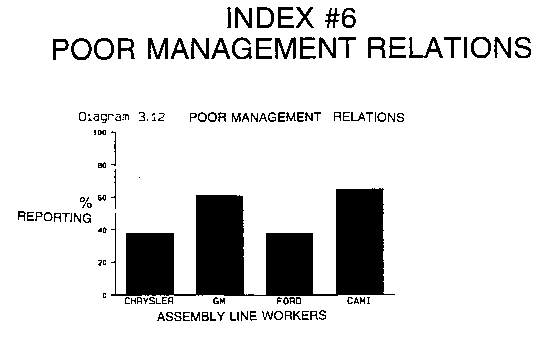
Table 3.3 provides a more detailed picture of workload at our four companies.
It includes both direct and indirect production workers. GM consistently
reports heavier loads on all four of our workload measures.
| TABLE 3.3: Detailed Workload Measures (% responding yes) | ||||
|---|---|---|---|---|
|
|
|
|
|
|
|
|
GM |
FORD |
CHRYSLER |
CAMI |
|
Work too heavy physically |
48 |
29 |
30 |
39 |
|
Work too fast |
77 |
40 |
40 |
46 |
|
Too few people to do work |
70 |
39 |
42 |
51 |
|
Too little time to do work |
66 |
38 |
33 |
42 |
|
Index |
79 |
41 |
39 |
46 |
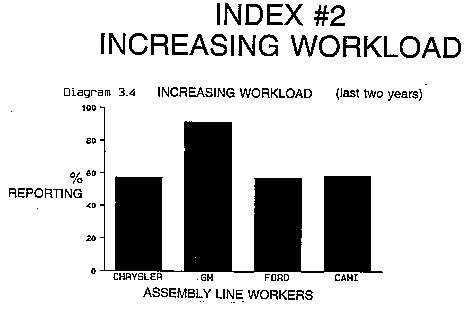
Table 3.4 provides a more detailed picture of which elements of work
have increased at each of the companies in the study. Workers at General
Motors were almost twice as likely to respond that their work had become
heavier, faster, or had to be done in less time.
| TABLE 3.4: CHANGE IN WORKLOAD (% responding yes) | ||||
|---|---|---|---|---|
|
|
|
|
|
|
|
|
GM | FORD | CHRYSLER | CAMI |
| Work heavier | 53 | 28 | 27 | 37 |
| Work faster | 86 | 46 | 45 | 49 |
| Less time to do work | 78 | 43 | 40 | 47 |
| Index | 92 | 57 | 57 | 59 |
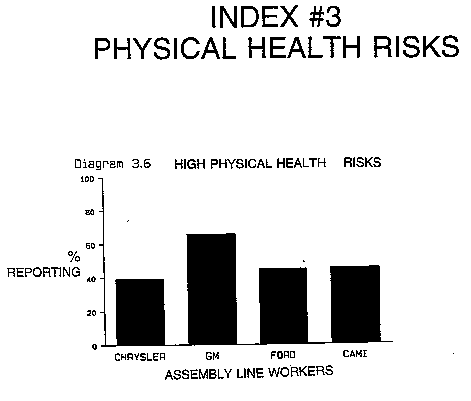
Table 3.5 provides a more detailed picture of physical health risks
at our four companies. GM workers were 10 to 20% more likely to respond
yes to each of the questions asked.
| TABLE 3.5: PHYSICAL RISKS (% responding yes) | ||||
|---|---|---|---|---|
|
|
|
|
|
|
|
|
GM | FORD | CHRYSLER | CAMI |
| Work in pain half the days in the last month | 67 | 46 | 43 | 42 |
| Work in an awkard position half the time | 60 | 43 | 41 | 54 |
| Exhausted after shift most days | 62 | 38 | 40 | 46 |
| Index | 66 | 45 | 39 | 45 |
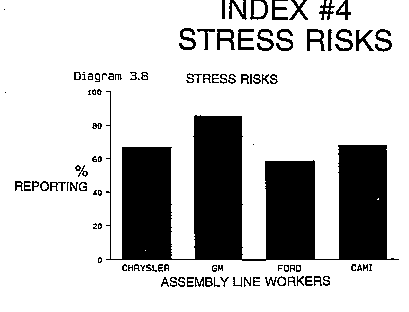
Table 3.6 provides a more detailed picture of stress related health
risks. While GM consistently reported the highest levels of stress related
health risks, the differences between companies were smaller and in some
cases the level of stress reported at CAMI was as high as that at GM.
| TABLE 3.6: STRESS RELATED HEALTH RISKS (% responding yes) | ||||
|---|---|---|---|---|
|
|
|
|
|
|
|
|
GM | FORD | CHRYSLER | CAMI |
| Tense at work | 76 | 54 | 51 | 61 |
| Too little energy for family at least half the time after work | 83 | 63 | 72 | 83 |
| Distaste at going to work at least half the time | 67 | 51 | 47 | 63 |
| Concerned about losing job in the next three years | 72 | 67 | 74 | 72 |
| Work as fast as you can at least half the time so you do not fall behind | 79 | 54 | 57 | 55 |
| Index | 86 | 59 | 67 | 68 |
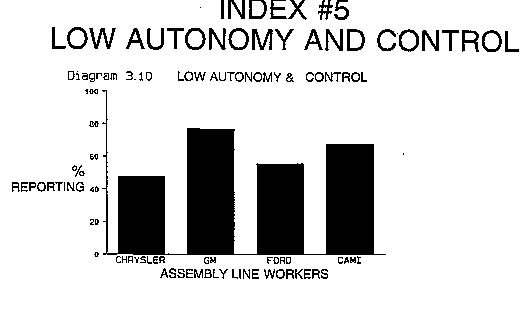
| TABLE 3.7: CONTROL and AUTONOMY (% responding yes) | ||||
|---|---|---|---|---|
|
|
|
|
|
|
|
|
GM | FORD | CHRYSLER | CAMI |
| Cannot vary the pace of work | 63 | 58 | 53 | 49 |
| Cannot do things other than work assigned | 81 | 66 | 66 | 64 |
| Cannot talk to other workers outside of breaks | 54 | 31 | 35 | 21 |
| Cannot leave work station | 63 | 55 | 65 | 65 |
| Cannot change things you do not like about your job | 78 | 77 | 70 | 82 |
| Cannot obtain light duty | 83 | 75 | 56 | 79 |
| Cannot keep up without working as fast as you can | 79 | 54 | 57 | 55 |
| Cannot get time off to attend to personal matters | 51 | 40 | 19 | 81 |
| Index | 77 | 55 | 48 | 67 |

Table 3.8 provides a more detailed picture of management relations at
our four companies. In general, workers were least likely to report dissatisfaction
with their immediate supervisor and most likely to report that management
was uninterested in their welfare. CAMI workers reported the highest levels
of dissatisfaction in terms of the fairness of management policies and
the extent to which management was interested in worker welfare.
| TABLE 3.8: MANAGEMENT RELATIONS (% responding yes) | GM | FORD | CHRYSLER | CAMI |
|---|---|---|---|---|
| Dissatisfied with immediate supervisor | 33 | 23 | 23 | 33 |
| Management policies not reasonable or fair | 61 | 36 | 34 | 67 |
| Management not interested in welfare | 74 | 58 | 58 | 76 |
| Index | 61 | 38 | 38 | 65 |
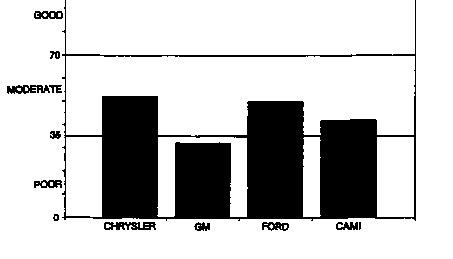

These charts combine the results of five of the six indexes to provide
a quick summary of how companies scored overall and how workers viewed
their working conditions. The charts indicate that working conditions were
the worst at GM followed by CAMI. Conditions were better at Ford and Chrysler
but it is important to keep in mind that even where Ford and Chrysler
reported better results, that they fell considerable below the threshold
of good working conditions. The results are also provided as a plant
by plant comparison.
![]() Click
here to return to the main CAW Digital Collections index page
Click
here to return to the main CAW Digital Collections index page